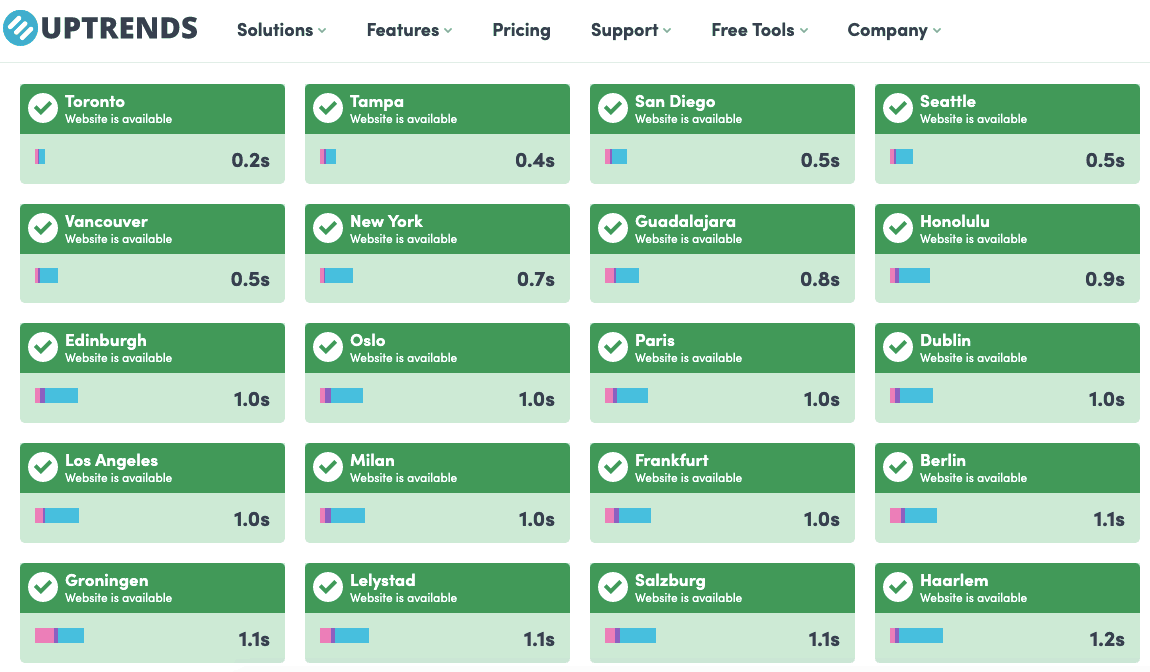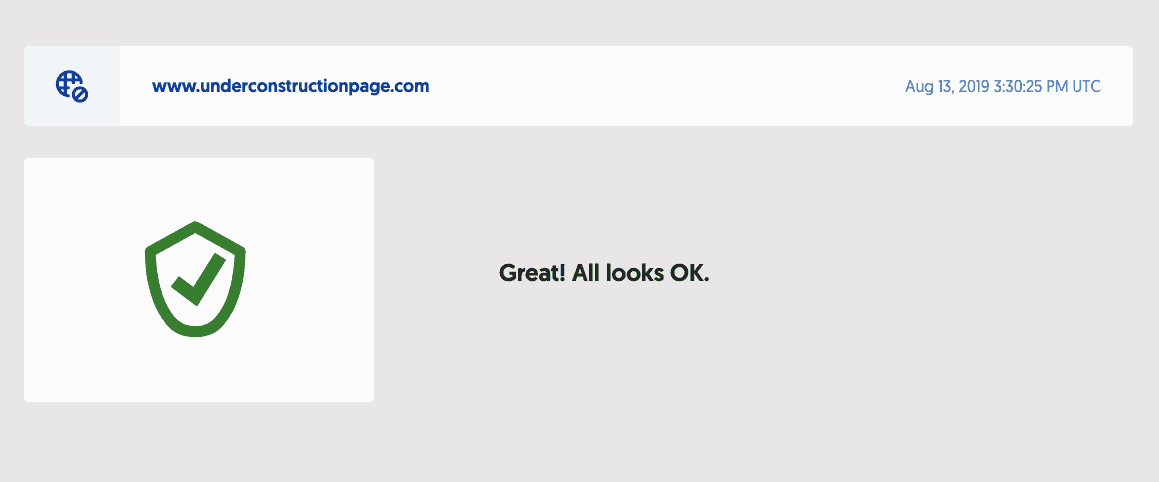WordPress website monitoring is a process that ensures a website is working just like it is supposed to and that there is no negative impact on user experience.
Of course, in the process of setting up your site for the first time, you will have to tweak a lot of things before you launch, including having an under construction page. When you are finally happy with the way your website looks and feels, you can present it to your audience.
But, if you think that the process of developing, testing and tweaking things stops here, you’re wrong. There is a lot that you need to do for your website to continue to run smoothly as always.
In this overview, we will show you all the monitoring tasks that await you if you want to run a great, optimized site.
First, we will take a look at some of the main benefits of constant WordPress monitoring, and then look at all the tasks it implies.
Why should I monitor my WordPress website?
For some users, monitoring WordPress website seems like a tedious task that can be postponed and ultimately avoided. It is true that monitoring tasks can be annoying to some users. Still, the fact remains that failing to monitor your site will inevitably have consequences.

So, here are some of the top things that should convince you to monitor your WordPress website:
#1 Website monitoring improves search engine ranking
For some users, this is one of the main reasons to continually monitor their website. Namely, Google is known to harshly penalize sites that have a slow loading time or load slowly on mobile (usually, these two come in a package).
For a website to be a constant guest of Google’s 1st page, it needs to have virtually zero downtime with extra-fast loading times.
If you have problems with some of these things, you will surely see your search engine ranking reflect this. Therefore, taking a few extra moments to make sure everything is going well is worth it in the long run, when your organic traffic soars.
#2 Fast websites increase sales
If your website experiences downtime issues frequently, you will see this in your monthly report as black holes in sales. When it comes to commerce, every minute of being online and up counts. There’s a well-known example of Amazon in 2007. During that year, Amazon reported a total profit of USD 14.8 billion, which equals to a whopping USD 29,000 every minute.
However, in June 2007, Amazon suffered a downtime period of two hours. It seems like ‘not so much’, but it led to a USD 3.48 million loss in only two hours.

Keeping uptime on a close to 100% is crucial for online stores. It stands all the same for all websites who monetize through sales.
#3 Improved customer satisfaction
When you make sure your website is fast and sleek, your visitors will thank you. As a user of the Internet yourself, you probably know how annoying a slow browsing experience can be. So, don’t let your visitors go through it too and offer them a perfect user experience: they will surely respond.
With today’s cutthroat competition of online brands, customers have never had it easier to go over to another website and change their loyalty in an instant.
If your website experiences frequent downtime, you can expect that you will start to see this happening.
#4 Protecting your brand
Your WordPress website is a direct extension of your business brand. Not only do you know this, but your customers are well aware of this, too. Usually, visitors and customers tend to identify websites and social media accounts as the mirrors of the actual company, which is, of course, correct.
The way your website performs will have a powerful impact on what new visitors think about your brand and its trustworthiness. If you are doing business in a trust-sensitive industry such as commerce, having a site that frequently experiences downtime will shatter your trust rates.

Giving your customers a picture-perfect image of a website that’s perfectly optimized and runs fast will speak volumes. It tells them about the good work that you do in your respective industry and your overall work ethic.
Website Monitoring Tasks
What exactly does website monitoring imply? If you are not really sure as to what you should do to keep your website optimized, we are bringing you a list of the main monitoring tasks you need to go through:
Speed testing (speed monitoring)
In today’s world, speed is not a perk, but an imperative. Your website needs to keep up and provide lightning-fast loading for your visitors to stick around. If you don’t offer this, someone else will.
No user likes a slow website. The speed of the site has a direct impact on many of the shiny goals you are probably tracking in your Analytics account. On top of that, speed is also crucial for SEO. If you’re running a turtle website, Google will easily hop over you and choose other sites over yours for the 1st page.
There are many free tools that you can use to manually check the speed of your WordPress website. Those free tools will give you a list of suggestions and help you with improving the speed of your site. Also, those same tools will show how much it will take for your website to load fully and the total size of the page.
But if you want to automatize your speed monitoring efforts, we suggest using services like Webmaster Ninja. With these types of tools, you will get automated notifications that there has been a drastic slow-down of your website speed.
This usually happens because of a typical performance issue. If the system recognizes the performance issue that’s slowing down your site, it will automatically provide explanations and tips on how to fix them.
Downtime Monitoring
It’s essential to be notified as soon as possible if your website is experiencing downtime. It is the worst thing that can happen to a page in the short term because it directly impacts the sales and profits you will make through your websites.
The most harmful effects of downtime will be felt in online stores. However, if you’re running a WordPress site that you’re monetizing through Google AdSense or other marketing channels, every minute your website is down is a missed opportunity to make money.
Just like with speed tests, there are two ways you can monitor downtime: manual and automatic.
The main drawback of checking whether your website is down manually is that you will find it out as quickly as your visitors do. Therefore, you should instead opt for automatic downtime monitoring. It works on a 5-minute or 10-minute basis and notifies you if your site is down.
If you really want to give yourself a hard time and check everything manually, you can choose some of the tools like WebSitePulse, Uptime by Uptrends, Service Uptime, or Uptime Robot. If your website is up and running, these tools will give you a result that looks like this

Blacklist monitoring
Google’s blacklist is not the place to be. If your website gets to this point of search engine hate, you can forget about that beautiful, free, organic traffic.
There are many reasons why Google can blacklist your website and stop showing it in search results. Some of the most common ones include:
Black hat SEO techniques
You have used some of the frowned-upon methods to get ahead in Google’s ranking. These could be keyword stuffing, cloaking links, spam, etc.
Viruses and malware
Don’t worry, it happens even to the best of us. If your website picked up a piece of malware which is affecting visitors, Google would instantly blacklist it as soon as it notices.

Directing to fishy websites
Your website needs to be squeaky-clean. What’s more, all of the sites that you vouch for through the use of links and directing can get you on Google’s blacklist. If you host spam or phishing websites, be prepared to pay the price.
Blacklisting
Apart from the previous tests that we have mentioned, this is the only result that is not as easy to notice. If your website is down, you’ll see it as soon as you enter the URL. If it’s slow, you will be annoyed as it loads just like your other visitors.
But, when it comes to getting blacklisted by Google, things are not so obvious. It might take weeks or even months before you notice your website is not appearing in search engine results. You will see it due to some residue of organic traffic.
You will usually notice this by seeing a significant fall in organic traffic. If users have stopped coming to your website via Google, chances are you are on the blacklist.
There are many free online tests that you can use to monitor whether your website has been blacklisted by Google. You can use tests such as Geekflare’s Blacklist Test or a Blacklist Check Tool Chrome extension.
Hopefully, you will get this result:
But again, manually checking if your site has been blacklisted takes time. Actually, if you want to make sure you’re not blacklisted, you would have to check your site every single day. Instead, wouldn’t it be better if you could have someone notify you when that happens?
Of course it would, and that’s why you should have Webmaster Ninja constantly take care of your site. Not only it will check if Google blacklisted your site, but it will allow show you a fresh screenshot of your site so you know if something bad happened.
SSL Expiration Monitoring
If you run a website without an SSL certificate, it will do some severe damage to your website’s credibility and SEO.
If your SSL certificate expires, your website will most often be directed to a warning website. It will prompt users with a scary message saying, ‘Do you trust these people? You shouldn’t’.
This redirect can be harmful, especially for eCommerce sites. It’s valuable and recommended not to let your SSL certificates expire without your knowledge, even for one day.
If you experience this, and you don’t want your users to be freaked out by these messages, you can set up a simple Under Construction Page. It will let your users know that you will be back soon. You can use this page as a placeholder until you take your time to renew your SSL certificate.
Usually, your SSL certificate provider will give you some notification that your SSL is soon expiring. Still, the safest bet is to set up an additional SSL checking and notification system.
Domain Expiration Monitoring
The only thing worse than an SSL certificate expiration is an expiration of your domain name. When this happens, customers and visitors will not even get a courtesy warning message upon entering your website link. Instead, it will be like your website never existed.
Of course, your domain service provider will send you a bunch of emails beforehand if your domain is soon to expire. However, if you use several different emails for domain registration, and you didn’t check the connected email for a couple of weeks, your domain can easily go down without you wanting it.
It is why domain expiration monitoring is the second layer of safety. You want to make sure that your domain never expires. Your visitors should never have to face a scary blank site upon entering your URL.
Simple DNS Monitoring
DNS monitoring will help you keep track of any changes in the registration of your domain name. This can be very helpful if you’re monitoring a bigger number of websites. Or, if you want to keep certain domain names unused until you start using them actively.
DIY WordPress website monitoring vs. outsourcing
There are still many other smaller tasks that you should consider as website monitoring. As you can see, there are a lot of them. Going through all of these steps manually on a weekly or monthly basis can take up a lot of your time.
Of course, you can opt for monitoring your WordPress website yourself, but make sure that you’re using great tools that provide reliable and factual results.
If you want to outsource these tasks and automatize the monitoring of your WordPress site, Webmaster Ninja is definitely the tool you should have in your belt. If you choose to go with this option, you will get additional time for your passion and business. You get to focus on growing your business instead of maintaining your website in a technical sense.

